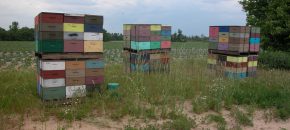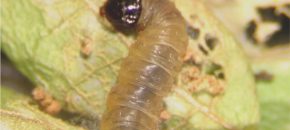Rhizoctonia root rot has been found on newly emerged cucurbit seedlings. The cool, cloudy weather has significantly slowed emergence and transplant growth the past few weeks. The longer it takes for emergence and transplants to establish themselves, the more likely they are to pick up pre- and post-emergent damping-off diseases such as Rhizoctonia or Pythium. […]
Continue reading...Veg IPM Update: Week Ending 5/11/16
Two-spotted spider mite (TSSM) infestations have recently been discovered in high tunnels. TSSM feeding results in small white pin-spots on the upper leaf surface (see photos). Mites are actually underneath leaves. These pests can increase dramatically in the warm, dry environment of the tunnel. Check 5 plants each in 5 separate locations in the tunnel. […]
Continue reading...Fruit IPM for 5-10-2016
Peach Oriental Fruit Moth: Oriental fruit moth is the primary key insect in peaches that is the ‘worm in the fruit’. It has 4 generations in NJ. During the first 2 flights, eggs are laid primarily on leaf petioles and growing shoots. Larvae hatch and mine down the new growth. As the larvae feed on […]
Continue reading...Potato | Tomato Disease Forecast 5-10-16
Click to View | Download Report 5-10-16 Potato Disease Forecasting Report We will be tracking DSVs for Late blight development and calculating P-days for initiating the first early blight fungicide application. The first late blight fungicide application is recommended once 18 DSVs accumulate from green row. Green row typically occurs around the first week in May […]
Continue reading...Beekeeper Notification for Pesticide Applications

Does a pesticide applicator need to notify beekeepers when applying a pesticide? That depends on these three factors: the specific pesticide being applied, the distance to the bee yard, and whether or not the beeyard is registered with the NJDEP. The NJ Pesticide Control Regulations, at NJAC 7:30-9.11, require that beekeepers must be notified when […]
Continue reading...Insect Pests to Look For in Cranberry Bogs: Early Season

The following insect pests bear special mention for early-season scouting in cranberry bogs: Blackheaded fireworm – Blackheaded fireworm eggs overwinter on the bed and usually hatch by around mid-May. It is important to catch the first generation, if possible, because the second generation occurs during bloom and is typically much more destructive. Blackheaded fireworm larvae […]
Continue reading...